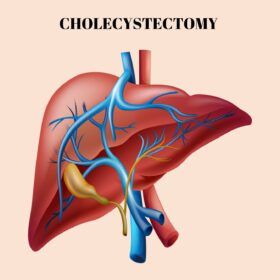
Simply Known as:
Gallbladder removal surgery, also known as a cholecystectomy, is a very common procedure. The gallbladder is a small, pouch-like organ in the upper right part of your tummy. It stores bile, a fluid produced by the liver that helps break down fatty foods.
Gallstones are hardened deposits of digestive fluid that can form in you. Gallstones range in size from as small as a grain of sand to as large as a golf ball. Some people develop just one gallstone, while others develop many gallstones at the same time.
People who experience symptoms from their gallstones usually require gallbladder removal surgery. Gallstones that don’t cause any signs and symptoms typically don’t need treatment.
SYMPTOMS:
Gallstones may cause no signs or symptoms. If a gallstone lodges in a duct and causes a blockage, the resulting signs and symptoms may include:
Sudden and rapidly intensifying pain in the upper right portion of your abdomen
Sudden and rapidly intensifying pain in the centre of your abdomen, just below your breastbone
Back pain between your shoulder blades
Pain in your right shoulder
Nausea or vomiting
Gallstone pain may last several minutes to a few hours.
CAUSES:
It’s not clear what causes gallstones to form. Doctors think gallstones may result when:
Your bile contains too much cholesterol. Normally, your bile contains enough chemicals to dissolve the cholesterol excreted by your liver. But if your liver excretes more cholesterol than your bile can dissolve, the excess cholesterol may form into crystals and eventually into stones.
Your bile contains too much bilirubin. Bilirubin is a chemical that’s produced when your body breaks down red blood cells. Certain conditions cause your liver to make too much bilirubin, including liver cirrhosis, biliary tract infections and certain blood disorders.
The excess bilirubin contributes to gallstone formation.
Your gallbladder doesn’t empty correctly. If your gallbladder doesn’t empty completely or often enough, bile may become very concentrated, contributing to the formation of gallstones.
TYPES:
Types of gallstones that can form in the gallbladder include:
Cholesterol gallstones.
The most common type of gallstone, called a cholesterol gallstone, often appears yellow in colour. These gallstones are composed mainly of undissolved cholesterol, but may contain other components.
Pigment gallstones.
These dark brown or black stones form when your bilecontains too much bilirubin
RISK FACTORS:
Factors that may increase your risk of gallstones include:
Being overweight or obese
Being sedentary
Eating a high-fat diet
Eating a high-cholesterol diet
Eating a low-fibre diet
Having a family history of gallstones
Having diabetes
Having certain blood disorders, such as sickle cell anaemia or leukaemia
Losing weight very quickly
Taking medications that contain oestrogen, such as oral contraceptives or hormone therapy drugs
Having liver disease
COMPLICATIONS:
Complications of gallstones may include:
Inflammation of the gallbladder. A gallstone that becomes lodged in the neck of the gallbladder can cause inflammation of the gallbladder (cholecystitis). Cholecystitis can cause severe pain and fever.
Blockage of the common bile duct. Gallstones can block the tubes (ducts) through which bile flows from your gallbladder or liver to your small intestine. Severe pain, jaundice and bile duct infection can result.
Blockage of the pancreatic duct. The pancreatic duct is a tube that runs from the pancreas and connects to the common bile duct just before entering the duodenum. Pancreatic juices, which aid in digestion, flow through the pancreatic duct.
A gallstone can cause a blockage in the pancreatic duct, which can lead to inflammation of the pancreas (pancreatitis). Pancreatitis causes intense, constant abdominal pain and usually requires hospitalization.
Gallbladder cancer. People with a history of gallstones have an increased risk of gallbladder cancer. But gallbladder cancer is very rare, so even though the risk of cancer is elevated, the likelihood of gallbladder cancer is still very small.
PREVENTION:
You can reduce your risk of gallstones if you:
Don’t skip meals. Try to stick to your usual mealtimes each day. Skipping meals or fasting can increase the risk of gallstones.
Lose weight slowly. If you need to lose weight, go slow. Rapid weight loss can increase the risk of gallstones. Aim to lose 1 or 2 pounds (about 0.5 to 1 kilogram) a week.
Eat more high-fibre foods. Include more fibre-rich foods in your diet, such as fruits, vegetables and whole grains.
Maintain a healthy weight. Obesity and being overweight increase the risk of gallstones. Work to achieve a healthy weight by reducing the number of calories you eat and increasing the amount 76 of physical activity you get. Once you achieve a healthy weight, work to maintain that weight by continuing your healthy diet and continuing to exercise.
SURGERY FOR GALLBLADDER STONE
The gallbladder is not an essential organ to human life. A surgeon can safely remove the gallbladder with a surgical procedure called cholecystectomy. There are two types of surgery for gallstones: laparoscopic/robotic and open surgery.
Laparoscopic/robotic cholecystectomy
According to the NIDDK trusted Source, surgeons are more likely to perform a laparoscopic procedure than an open procedure. During laparoscopic cholecystectomy, a surgeon will use general anaesthetics to put the person to sleep.
Then, they will make three or four incisions and place devices, called ports, into the incisions to allow better access to the gallbladder. The surgeon will use a small camera to help them remove the gallbladder, before sealing the openings with stitches or staples.
In some cases, they may use robotics to help with the surgery. These procedures are very similar to other laparoscopic cholecystectomies. The only difference is that the surgeon will manipulate the robot to perform the procedure.
During the procedure, they may need to remove gallstones that are blocking one or more bile ducts. They may need to use X-ray to help them see any additional stones
